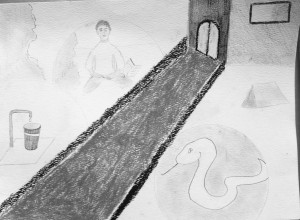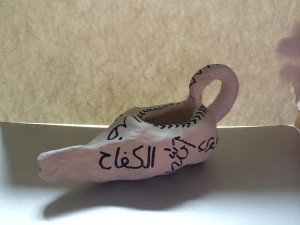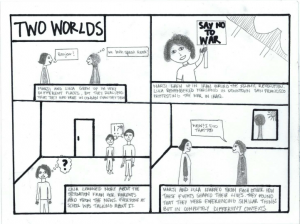Entries from October 2014
October 31st, 2014 · Comments Off on We Delicate Women
It is we delicate women who carry our own weight
We delicate women who venture out into unchartered lands
We delicate women fight for our power
We delicate women who defend our own for their rights
To live, to dream, to act, to succeed
While those with power try to strip us of our dignity, our rights, our choices
It is we delicate women who stand up for our rights to choose how we dress,
Whether that is a miniskirt or a hijab, or a miniskirt and a hijab.
It is we delicate women who discover our own buried
In the rubble of the walls we are tearing down.
We delicate women who find that we cannot be condensed to a singular adjective
That our worth cannot be determined by people unworthy of our accomplishments.
We strong women, we ambitious women, we exceptional women, we brave women.
We can find more accurate words to describe us,
But a single adjective or an assortment of words cannot encompass
The multitude of perspectives, lives and dreams that we have.
We Sinful Women is a collection of poems written by women that explore life for Muslim women. These poems represent a perspective that is ofter overlooked or under appreciated. The poem “We Sinful Women” deals with things women have to deal with in the world and in Muslim societies. The title itself is represents how women are being characterized by men as “sinful”. Throughout the poem, the author is using sinful and is defending women against what people say about them. The author brings up relevant points about things that women have to deal with. Throughout the poem, there are mentions of different constraints women have to deal with and how in reality it is often times the men who are sinful or held to very different standards than women are.
As a response to the poems, I chose to write my own poem stemming from “We Sinful Women”. I chose to keep certain ideas in my poem, such as a title that shows reproaches women in the world have to deal with and then continues with things that women have overcome and are still dealing with. I chose the word “delicate” to base my poem on, because I felt it accurately characterized a sentiment that people have that women are weaker and less able to handle things. Delicate at first seems like it could be a positive thing, but really only demeans women. There are a lot of similarities between my poem and “We Sinful Women” and I feel that my poem represents a different angle and perspective of a common feeling.
Tags: Uncategorized
October 31st, 2014 · Comments Off on A View into the Alley

Children of the Alley by Naguib Mahfouz is the story of an alley and one family throughout multiple generations. Different descendants of Gabalawi, the owner of the house at the beginning of the alley, represent different prophets and religious figures. There are multiple sections in the novel, each pertaining to a different religious figure, Moses, Jesus, Muhammad. Other sections deal with people like Cain and Abel and even the push towards science as opposed to religion.
In my creative response, I chose to draw the alley and represent different elements of different sections, and of religion. The house at the beginning of the alley belongs to Gabalawi, who could represent God or just religion in general. The window into the house shows the sun and how in each generation there was a motivation to reenter the house of Gabalawi to help the people of the alley. Similar to God, the people in the alley had not seen Gabalawi, but believe, for the most part, in him anyways. The snake represents the story of Gebel, a snake charmer who could be said to represent Moses in his values and his actions. The water pail on the left side of the alley represents Rifaa and his life of purity and his desire to purify people from their sins. Rifaa would represent Jesus. The man meditating represents Kassem in the desert, next to him is a book that represents the message that Kassem has been given by Gabalawi’s servant. Kassem would represent Muhammad. There are other elements in my drawing that represent ideas in the novel such as the rocks in the desert and the tent next to Gabalawi’s.
Tags: Uncategorized
October 31st, 2014 · Comments Off on My Saint’s Lamp


In The saint’s lamp by Yahya Haqqi the protagonist, Ismail, grows up in Egypt and then goes to Europe to study medicine. When he returns after his long studies, he has trouble accepting the difference between science and religion in his home. At home, a lot of the healing is derived from faith and religion, after studying to become a doctor, he no longer understands how people can choose religion over science. Throughout the novel, there is an oil lamp, a saint’s lamp, that is used to heal people. Ismail’s wife is losing her sight and Ismail must overcome his new aversion to religion in order to combine science and faith and save his wife’s eyesight.
For my creative response, I molded an oil lamp out of clay and wrote different words in Arabic and Urdu that I believe related to the story. Words such as faith and God are inscribed on the oil lamp to visually represent what the symbolic meaning of the oil lamp in the story was. I thought the idea of making an oil lamp out of clay was interesting because compared to other mediums, shaping things out of clay has less to do with sight and more to do with feel. I feel that the process of making the lamp paralleled the process Ismail went through in healing his wife’s eyes.
Tags: Uncategorized
October 31st, 2014 · Comments Off on Two Worlds: A Response to Persepolis

In Persepolis: The Story of a Childhood, Marjane Satrapi draws a semi-autobiographical story about her childhood in Iran during the Islamic revolution. Something that I found interesting about this graphic novel was the use of a child narrator. I felt that through Marji’s voice, the reader was able to understand even more about what was happening in Iran during this time. There is a certain naivety that children have that allows them to ask any questions and sometimes understand the real meaning of the answers.
My creative piece explores in a similar medium, a comic, the parallels between children’s lives around the world. Something that affected my childhood was 9/11 and all of the proceeding events. As I was reading Persepolis, there were things that Marji did, like go into the streets to protest, that reminded me of things that I did in the early 2000s. In my drawing, I show Marji and myself at a younger age meeting, at first we connect on a more superficial level, realizing we both speak French, by the end we realize that the things we have in common go even farther than just speaking the same language. My drawings show a parallel between Marji’s life and my life, but put our similar experiences in different contexts.
Tags: Uncategorized




